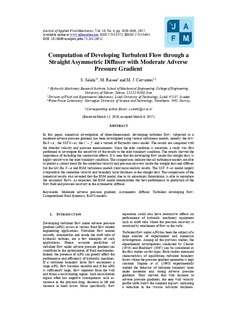| dc.contributor.author | Salehi, S | |
| dc.contributor.author | Raisee, M | |
| dc.contributor.author | Cervantes, Michel | |
| dc.date.accessioned | 2019-09-16T11:03:37Z | |
| dc.date.available | 2019-09-16T11:03:37Z | |
| dc.date.created | 2017-09-13T15:33:25Z | |
| dc.date.issued | 2017 | |
| dc.identifier.citation | Journal of Applied Fluid Mechanics. 2017, 10 (4), 1029-1043. | nb_NO |
| dc.identifier.issn | 1735-3572 | |
| dc.identifier.uri | http://hdl.handle.net/11250/2616963 | |
| dc.description.abstract | In this paper, numerical investigation of three-dimensional, developing turbulent flow, subjected to a moderate adverse pressure gradient, has been investigated using various turbulence models, namely: the lowRe k , the SST k , the 2 v f and a variant of Reynolds stress model. The results are compared with the detailed velocity and pressure measurements. Since the inlet condition is uncertain, a study was first performed to investigate the sensitivity of the results to the inlet boundary condition. The results showed the importance of including the contraction effects. It is seen that the developing flow inside the straight duct, is highly sensitive to the inlet boundary condition. The comparisons indicate that all turbulence models are able to predict a correct trend for the centerline velocity and pressure recovery inside the straight duct and diffuser but the low-Re k and RSM turbulence models yield more realistic results. The SST k model largely overpredicts the centerline velocity and boundary layer thickness in the straight duct. The comparisons of the numerical results also revealed that the RSM model, due to its anisotropic formulation, is able to reproduce the secondary flows. As expected, the RSM model demonstrates the best performance in prediction of the flow field and pressure recovery in the asymmetric diffuser. | nb_NO |
| dc.language.iso | eng | nb_NO |
| dc.publisher | Isfahan University of Technology | nb_NO |
| dc.rights | Attribution-NonCommercial-NoDerivatives 4.0 Internasjonal | * |
| dc.rights.uri | http://creativecommons.org/licenses/by-nc-nd/4.0/deed.no | * |
| dc.title | Computation of developing turbulent flow through a straight asymmetric diffuser with moderate adverse pressure gradient | nb_NO |
| dc.type | Journal article | nb_NO |
| dc.type | Peer reviewed | nb_NO |
| dc.description.version | publishedVersion | nb_NO |
| dc.source.pagenumber | 1029-1043 | nb_NO |
| dc.source.volume | 10 | nb_NO |
| dc.source.journal | Journal of Applied Fluid Mechanics | nb_NO |
| dc.source.issue | 4 | nb_NO |
| dc.identifier.doi | 10.18869/acadpub.jafm.73.241.26311 | |
| dc.identifier.cristin | 1493436 | |
| dc.description.localcode | This work is licensed under a Creative Commons Attribution-NonCommercial-NoDerivatives 4.0 International License. | nb_NO |
| cristin.unitcode | 194,64,25,0 | |
| cristin.unitname | Institutt for energi- og prosessteknikk | |
| cristin.ispublished | true | |
| cristin.fulltext | original | |
| cristin.qualitycode | 1 | |

